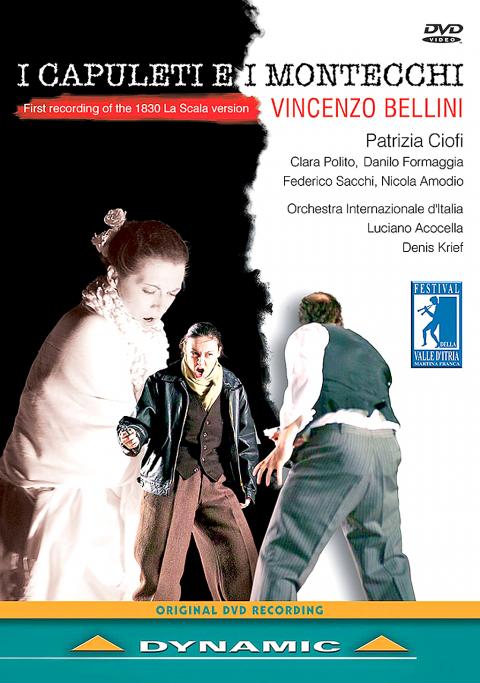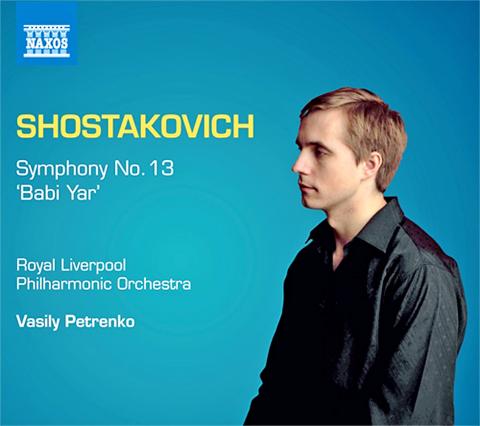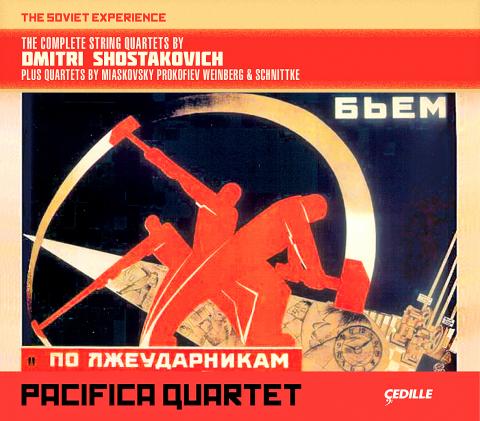I CAPULETI E I MONTECCHI
By Vincenzo Bellini
Ciofi, Polito

Dynamic 33504
Considerable excitement seems to have been provoked in anticipation of the release this week of San Francisco Opera’s DVD of their production of I Capuleti e I Montecchi (The Capulets and the Montagues), Vincenzo Bellini’s not very close operatic approximation to Shakespeare’s Romeo and Juliet. We wrote earlier about a fine DVD version from 2008 starring Anna Netrebko [Taipei Times, March 26, 2013], together with her different version, also from 2008 but issued only on CD. There, we outlined the opera’s bizarre alterations to the original story, plus Bellini’s decision to use females for both the principal roles.
The San Francisco production, released on DVD earlier this week, stars one of the finest “bel canto” (beautiful singing) exponents available, Joyce DiDonato, as Romeo — the role she sang opposite Netrebko on the 2008 DVD. Extracts available on YouTube display not only her dynamic brilliance but also the musical vibrancy of the whole enterprise and the high-tech quality of the recording. Available visuals show the costumes by the celebrated designer Christian Lacroix to be restrained, even severe. Vincent Boussard is the director.

Meanwhile, versions of this once neglected work continue to proliferate. It forms a recent addition, for example, to the Naxos Video Library in a version from the Dynamic label. This is outstanding, this time on account of the presence of Patrizia Ciofi as Giulietta (Juliet). Her voice is resplendent by any standards, and her Romeo, Clara Polito, isn’t far behind. It was recorded in 2005 at the Festival of the Valle d’Itria. It is conducted by Luciano Acocella, is in modern dress, and has plenty of menace from the male participants. The staging — inside the Palazzio Ducale, Martina Franca — is minimal, but finely sung throughout.
A complete production of this opera from Japan is available on YouTube. It features Mariella Devia as Giulietta, Sonia Ganassi as Romeo, plus Japanese singers — all excellent — as the male soloists. The production is coordinated with great nimbleness and brio by the Tokyo Philharmonic Orchestra, with Daniele Callegari as conductor. Once the curtain goes up, the strength of the traditional costumes and staging are immediately apparent. Unfortunately, however, there are no subtitles.
But whether the star is Giulietta or Romeo, and the artist Netrebko, DiDonato or Ciofi, it is evidently Bellini’s long, melodic lines that unfailingly intoxicate the viewers. This is supremely beautiful music, so much so that some have been led to say it lacks seriousness. This can hardly be so, however, as the tradition it stands in is one that sees beauty as a sign of the presence of divinity. Bellini’s music is part of the ageless cult of the “Religion of Beauty.”

SYMPHONY No: 13 (“Babi Yar”)
By Dmitri Shostakovich
Petrenko, Royal Liverpool Philharmonic Orchestra
Naxos 8573218
Russian composer-pianist Dmitri Shostakovich, by contrast, could hardly be more different. With him the morose alternates with the scabrous and political meanings are hinted at frequently. But this is music that is monumental and undoubtedly representative of 20th century history. If it’s the 15 quartets that embody the composer’s brooding introspection, it’s the 15 symphonies that stand for his more public pronouncements.
Here, Naxos has a huge achievement under its belt, as last month signaled the conclusion of its Shostakovich Symphonic Cycle, with the Royal Liverpool Philharmonic Orchestra under the still relatively youthful Vasily Petrenko.
The final item to be released, the Symphony No: 13 (“Babi Yar”), is a dense, apocalyptic work composed around five poems by Yevgeny Yevtushenko. These all center on German anti-Semitism, with the first focusing on the nightmarish massacre of Jews by Nazi forces during World War II at the Babi Yar ravine in Kiev, the modern capital of Ukraine. Over 33,000 people were murdered there in a single, hideous operation.
Soviet anti-Semitism is also touched upon in the symphony. Moscow authorities were alerted of the work in 1962, which led to the withdrawal of the original conductor and bass soloist prior to the premiere. The concert went ahead nonetheless, although Yevtushenko was pressured to revise some of his poems for later performances. Shostakovich, by contrast, never wrote the revised words into his personal score.
Jewish influences are detectable in many places in Shostakovich’s music, but this symphony must stand as his major indictment of the Holocaust as a whole. Petrenko’s version has been widely praised, as has the bass soloist Alexander Vinogradov, even if the choral forces (the Royal Liverpool Philharmonic Choir and the Huddersfield Choral Society) have sometimes been deemed to lack the sonorous masculinity of a true Russian male-voice choir.
But what really deserves the fullest praise is Petrenko’s achievement over the cycle as a whole. What with the unexpectedly persuasive 3rd, the attention to unnoticed corners of the 5th, the magnificent, unparalleled 8th, and the universally acclaimed 10th, his versions are likely, on the whole, the finest in the catalogue.
THE SOVIET EXPERIENCE
Pacifica Quartet
Complete Shostakovich quartets and more
Cedille BOX 1003
Finally, an attractive boxed set has emerged from the Cedille label containing all of Shostakovich’s string quartets, plus four quartets by his contemporaries, each played by the US-based Pacifica Quartet. The tone is sensitive rather than abrasive, and the whole package, four CDs containing 19 quartets, has been highly praised. The additional composers represented are Nikolai Miaskovsky, Alfred Schnittke, Sergei Prokofiev and Mieczyslaw Weinberg.

May 11 to May 18 The original Taichung Railway Station was long thought to have been completely razed. Opening on May 15, 1905, the one-story wooden structure soon outgrew its purpose and was replaced in 1917 by a grandiose, Western-style station. During construction on the third-generation station in 2017, workers discovered the service pit for the original station’s locomotive depot. A year later, a small wooden building on site was determined by historians to be the first stationmaster’s office, built around 1908. With these findings, the Taichung Railway Station Cultural Park now boasts that it has

Wooden houses wedged between concrete, crumbling brick facades with roofs gaping to the sky, and tiled art deco buildings down narrow alleyways: Taichung Central District’s (中區) aging architecture reveals both the allure and reality of the old downtown. From Indigenous settlement to capital under Qing Dynasty rule through to Japanese colonization, Taichung’s Central District holds a long and layered history. The bygone beauty of its streets once earned it the nickname “Little Kyoto.” Since the late eighties, however, the shifting of economic and government centers westward signaled a gradual decline in the area’s evolving fortunes. With the regeneration of the once

In February of this year the Taipei Times reported on the visit of Lienchiang County Commissioner Wang Chung-ming (王忠銘) of the Chinese Nationalist Party (KMT) and a delegation to a lantern festival in Fuzhou’s Mawei District in Fujian Province. “Today, Mawei and Matsu jointly marked the lantern festival,” Wang was quoted as saying, adding that both sides “being of one people,” is a cause for joy. Wang was passing around a common claim of officials of the People’s Republic of China (PRC) and the PRC’s allies and supporters in Taiwan — KMT and the Taiwan People’s Party — and elsewhere: Taiwan and

Even by the standards of Ukraine’s International Legion, which comprises volunteers from over 55 countries, Han has an unusual backstory. Born in Taichung, he grew up in Costa Rica — then one of Taiwan’s diplomatic allies — where a relative worked for the embassy. After attending an American international high school in San Jose, Costa Rica’s capital, Han — who prefers to use only his given name for OPSEC (operations security) reasons — moved to the US in his teens. He attended Penn State University before returning to Taiwan to work in the semiconductor industry in Kaohsiung, where he